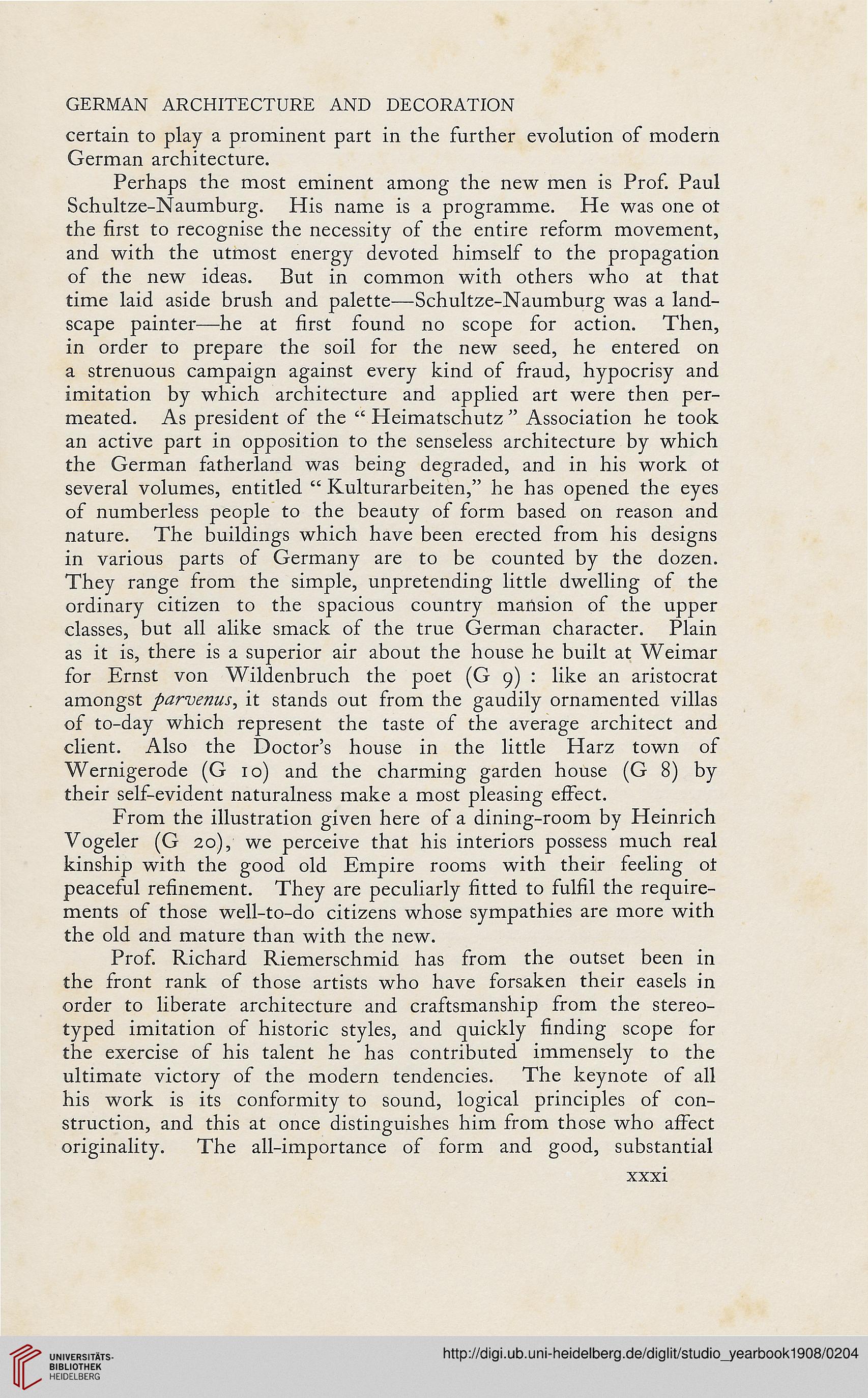GERMAN ARCHITECTURE AND DECORATION
certain to play a prominent part in the further evolution of modern
German architecture.
Perhaps the most eminent among the new men is Prof. Paul
Schultze-Naumburg. His name is a programme. He was one ot
the first to recognise the necessity of the entire reform movement,
and with the utmost energy devoted himself to the propagation
of the new ideas. But in common with others who at that
time laid aside brush and palette—Schultze-Naumburg was a land-
scape painter—he at first found no scope for action. Then,
in order to prepare the soil for the new seed, he entered on
a strenuous campaign against every kind of fraud, hypocrisy and
imitation by which architecture and applied art were then per-
meated. As president of the " Heimatschutz " Association he took
an active part in opposition to the senseless architecture by which
the German fatherland was being degraded, and in his work ot
several volumes, entitled " Kulturarbeiten," he has opened the eyes
of numberless people to the beauty of form based on reason and
nature. The buildings which have been erected from his designs
in various parts of Germany are to be counted by the dozen.
They range from the simple, unpretending little dwelling of the
ordinary citizen to the spacious country mansion of the upper
classes, but all alike smack of the true German character. Plain
as it is, there is a superior air about the house he built at Weimar
for Ernst von Wildenbruch the poet (G 9) : like an aristocrat
amongst parvenus, it stands out from the gaudily ornamented villas
of to-day which represent the taste of the average architect and
client. Also the Doctor's house in the little Harz town of
Wernigerode (G 10) and the charming garden house (G 8) by
their self-evident naturalness make a most pleasing effect.
From the illustration given here of a dining-room by Heinrich
Vogeler (G 20), we perceive that his interiors possess much real
kinship with the good old Empire rooms with their feeling ot
peaceful refinement. They are peculiarly fitted to fulfil the require-
ments of those well-to-do citizens whose sympathies are more with
the old and mature than with the new.
Prof. Richard Riemerschmid has from the outset been in
the front rank of those artists who have forsaken their easels in
order to liberate architecture and craftsmanship from the stereo-
typed imitation of historic styles, and quickly finding scope for
the exercise of his talent he has contributed immensely to the
ultimate victory of the modern tendencies. The keynote of all
his work is its conformity to sound, logical principles of con-
struction, and this at once distinguishes him from those who affect
originality. The all-importance of form and good, substantial
xxxi
certain to play a prominent part in the further evolution of modern
German architecture.
Perhaps the most eminent among the new men is Prof. Paul
Schultze-Naumburg. His name is a programme. He was one ot
the first to recognise the necessity of the entire reform movement,
and with the utmost energy devoted himself to the propagation
of the new ideas. But in common with others who at that
time laid aside brush and palette—Schultze-Naumburg was a land-
scape painter—he at first found no scope for action. Then,
in order to prepare the soil for the new seed, he entered on
a strenuous campaign against every kind of fraud, hypocrisy and
imitation by which architecture and applied art were then per-
meated. As president of the " Heimatschutz " Association he took
an active part in opposition to the senseless architecture by which
the German fatherland was being degraded, and in his work ot
several volumes, entitled " Kulturarbeiten," he has opened the eyes
of numberless people to the beauty of form based on reason and
nature. The buildings which have been erected from his designs
in various parts of Germany are to be counted by the dozen.
They range from the simple, unpretending little dwelling of the
ordinary citizen to the spacious country mansion of the upper
classes, but all alike smack of the true German character. Plain
as it is, there is a superior air about the house he built at Weimar
for Ernst von Wildenbruch the poet (G 9) : like an aristocrat
amongst parvenus, it stands out from the gaudily ornamented villas
of to-day which represent the taste of the average architect and
client. Also the Doctor's house in the little Harz town of
Wernigerode (G 10) and the charming garden house (G 8) by
their self-evident naturalness make a most pleasing effect.
From the illustration given here of a dining-room by Heinrich
Vogeler (G 20), we perceive that his interiors possess much real
kinship with the good old Empire rooms with their feeling ot
peaceful refinement. They are peculiarly fitted to fulfil the require-
ments of those well-to-do citizens whose sympathies are more with
the old and mature than with the new.
Prof. Richard Riemerschmid has from the outset been in
the front rank of those artists who have forsaken their easels in
order to liberate architecture and craftsmanship from the stereo-
typed imitation of historic styles, and quickly finding scope for
the exercise of his talent he has contributed immensely to the
ultimate victory of the modern tendencies. The keynote of all
his work is its conformity to sound, logical principles of con-
struction, and this at once distinguishes him from those who affect
originality. The all-importance of form and good, substantial
xxxi




